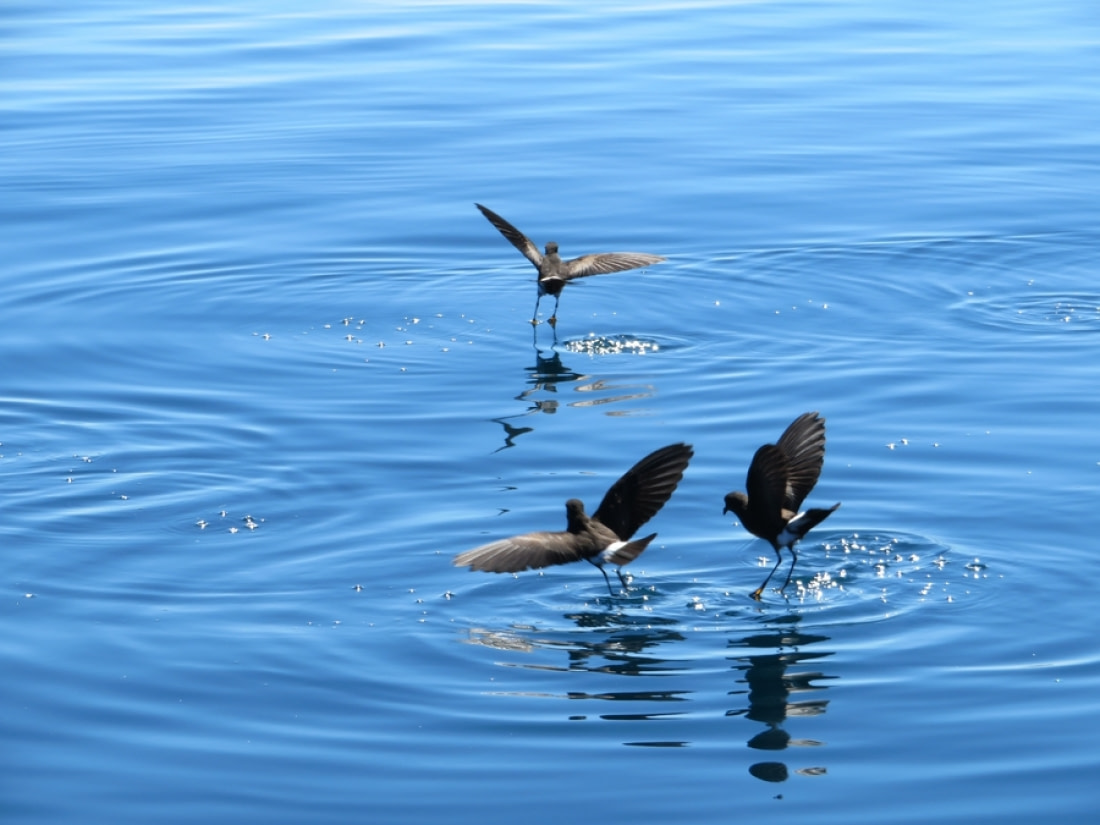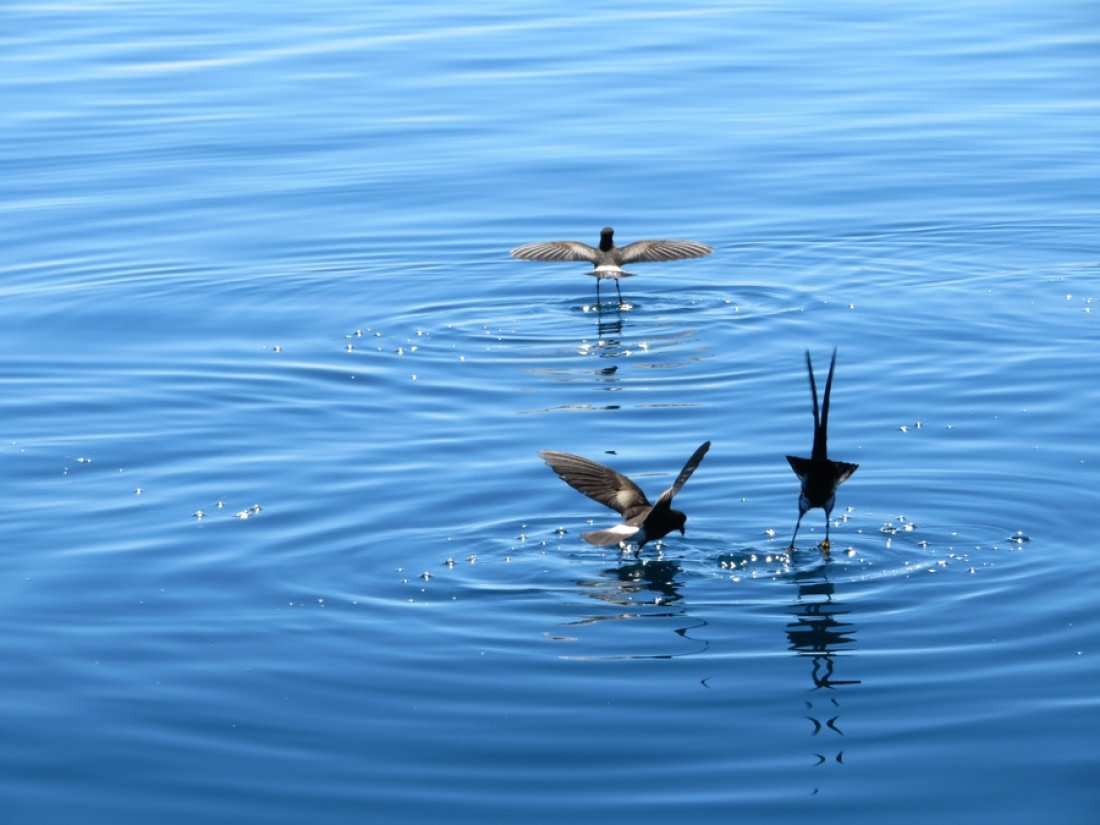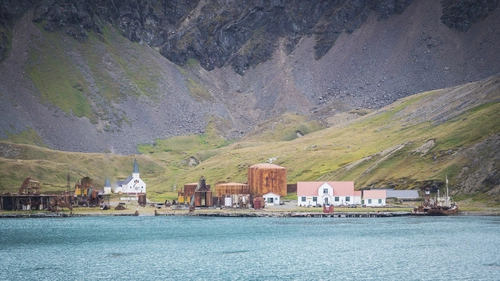Name: Storm Petrel. Note - "Storm Petrel" refers to two subfamilies of birds with various species.
Length: 13 to 26 cm, depending on species.
Weight: Depends on species.
Location: Oceans worldwide.
Conservation status: Depends on species.
Diet: Crustaceans, small fish, molluscs.
Appearance: Oceanitinae - Square tails, long skulls, long legs, short wings. Most species have dark backs and heads with white underparts. Hydrobatinae - Forked or wedge-shaped tails, longer wings, shorter legs. Most are darker with white on the rump. The Fork-tailed Storm Petrel is grey, and Hornby's Storm Petrel has white facial markings and undersides.

How do Storm Petrels feed?
Storm Petrels hover above water to pick small crustaceans and fish from just under the surface. They can make shallow dives but rarely do. They are often seen near underwater predators like whales or seals that chase prey fish to the surface.
Are Storm Petrels social?
Storm Petrels form colonies during nesting season, ranging from hundreds of thousands to millions.
What are Storm Petrel birthing rituals like?
Storm Petrels return yearly to the same nesting locations, building nests in burrows or rock crevices. All but one species become nocturnal at nesting sites to avoid predators. Adults are monogamous, laying a single egg. Both parents take turns incubating the egg for about 50 days in 6-day shifts, followed by a 70-day rearing period.

How long do Storm Petrels live?
Storm Petrels can live for around 30 years.
Do Storm Petrels have any natural predators?
Storm Petrel eggs and young are preyed upon by introduced mammals like feral cats and rats, as well as Skuas and Gulls, depending on the nest's location.
7 Stunning Storm Petrel Facts
- Storm Petrels show a strong sense of philopatry, meaning they return to the same nesting sites season after season.
- The subfamilies of Storm Petrels are:
- Subfamily: Hydrobatinae
- Hydrobates pelagicus - European Storm Petrel
- Oceanodroma castro - Band-rumped Storm Petrel
- Oceanodroma furcate - Fork-tailed Storm Petrel
- Oceanodroma homochroa - Ashy Storm Petrel
- Oceanodroma hornbyi - Hornby's Storm Petrel
- Oceanodroma leucorhoa - Leach's Storm Petrel
- Oceanodroma macrodactyla - Guadalupe Storm Petrel (extinct)
- Oceanodroma markhami - Markham's Storm Petrel
- Oceanodroma melania - Black Storm Petrel
- Oceanodroma microsoma - Least Storm Petrel
- Oceanodroma monorhis - Swinhoe's Storm Petrel
- Oceanodroma monteiroi - Monteiro's Storm Petrel
- Oceanodroma Tethys - Wedge-rumped Storm Petrel
- Oceanodroma tristrami - Tristram's Storm Petrel
- Subfamily: Oceanitinae
- Fregetta grallaria - White-bellied Storm Petrel
- Fregetta tropica - Black-bellied Storm Petrel a.k.a. Gould's Storm Petrel
- Garrodia nereis - Grey-backed Storm Petrel
- Nesofregetta fuliginosa - Polynesian Storm Petrel (includes White-throated Storm Petrel)
- Oceanites gracilis - Elliot's Storm Petrel
- Oceanites maorianus - New Zealand Storm Petrel
- Oceanites oceanicus - Wilson's Storm Petrel
- Pelagodroma marina - White-faced Storm Petrel
- Subfamily: Hydrobatinae
- Storm Petrels are the smallest seabirds in the world.
- "Petrel" refers to Saint Peter walking on water.
- Storm Petrels have weak legs that can only support a few steps on land.
- Sailors used to call Storm Petrels "Mother Carey's chickens," a divine warning of storms.
- They have also been called "water-witches," "satanites," "sataniques," and "oiseau du diable" ("bird of the devil") due to their storm association.











 23 Days / 22 Nights
23 Days / 22 Nights



